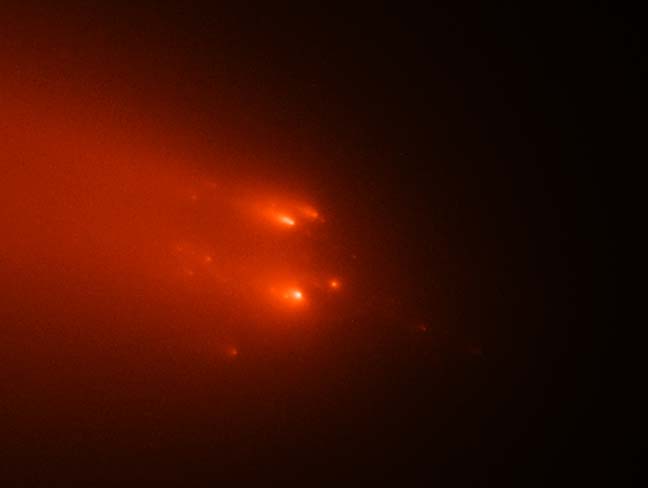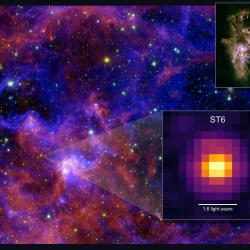Comet ATLAS May Have Been a Blast from the Past
UMD-led research suggests that a comet seen in 2020 is a remnant of one that crossed the sky during the Stone Age
University of Maryland astronomer Quanzhi Ye and colleagues discovered that a comet observed in early 2020 was the remnant of a comet that first streaked through the night sky 5,000 years ago. Their study appeared in The Astronomical Journal on July 21, 2021.
Ye and his colleagues identified the ancient source of the comet known as ATLAS (C/2019 Y4) after analyzing observations from the Hubble Space Telescope as the comet disintegrated into a cascade of small icy pieces in mid-2020. Previous analysis revealed that ATLAS followed the same orbital "railroad track" as that of a comet seen in 1844, which means the two comets are probably siblings from a parent comet that broke apart many centuries earlier.
Such comet families are common. The most dramatic visual example is the comet Shoemaker-Levy 9 (SL9), which broke into a string of pieces in July 1992 because of Jupiter’s gravitational pull. This "comet train" was short-lived and fell piece by piece into Jupiter in July 1994.
But comet ATLAS is just "weird," said Ye, who observed it with help from Hubble around the time of the breakup. Unlike its hypothesized parent comet, which swept within 23 million miles of the sun, ATLAS disintegrated over 100 million miles from the sun, which is farther from the sun than Earth.
"This emphasizes its strangeness," said Ye, an assistant research scientist in UMD’s Department of Astronomy and the study’s first author. "If it broke up this far from the sun, how did it survive the last passage around the sun 5,000 years ago? This is the big question. It's very unusual because we wouldn't expect it. This is the first time a long-period comet family member was seen breaking up before passing closer to the sun."
Observing the breakup of these fragments offers clues to how the parent comet was put together. The conventional wisdom is that comets are fragile agglomerations of dust and ice, and they may be lumpy, like a pudding with clumps of raisins. After a year of analysis, Ye and his co-investigators found that the various fragments of ATLAS had very different compositions—one piece disintegrated in a matter of days, while another piece lasted for weeks.
"This tells us that part of the nucleus was stronger than the other part," Ye said.
One possibility is that streamers of ejected material may have spun up the comet so fast that centrifugal forces tore it apart. An alternative explanation is that the comet has so-called super-volatile ices that just blew the piece apart like an exploding aerial firework.
"It is complicated because we start to see these hierarchies and evolution of comet fragmentation,” Ye said. “Comet ATLAS's behavior is interesting but hard to explain.”
Because comets are relics of a much earlier time, understanding them better will help astronomers learn about the evolution of the solar system. ATLAS was first detected in late 2019 by the Asteroid Terrestrial-impact Last Alert System operated by the University of Hawaii. An amateur astronomer named Maik Meyer first noted a link between ATLAS and reports of the comet seen in 1844. That comet, which is believed to be ATLAS's surviving sibling, won't return until the 50th century.
###
This story was adapted from text provided by the Space Telescope Science Institute.
An additional UMD co-author of the paper is astronomy associate research scientist Michael S. P. Kelley.
The research paper, “Disintegration of Long-period Comet C/2019 Y4 (ATLAS). I. Hubble Space Telescope Observations,” was published on July 21, 2021, in The Astronomical Journal.
Writer: Kimbra Cutlip
Media Relations Contact: Abby Robinson, 301-405-5845, abbyr@umd.edu
University of Maryland
College of Computer, Mathematical, and Natural Sciences
2300 Symons Hall
College Park, Md. 20742
www.cmns.umd.edu
@UMDscience
About the College of Computer, Mathematical, and Natural Sciences
The College of Computer, Mathematical, and Natural Sciences at the University of Maryland educates more than 9,000 future scientific leaders in its undergraduate and graduate programs each year. The college's 10 departments and more than a dozen interdisciplinary research centers foster scientific discovery with annual sponsored research funding exceeding $200 million.








